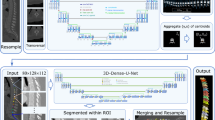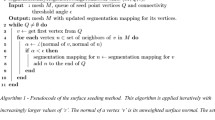Abstract
Purpose
Transforaminal endoscopic surgery (TES) is effective for treatment of intervertebral disc-related diseases. To avoid injury to the critical structures, preoperative planning is required to find a safe working channel. Therefore, accurate patient-specific vertebral segmentation is important. The purpose of this work is to develop a convenient, stable and feasible lumbar vertebrae segmentation method for TES planning.
Methods
Based on the chain structure of the spine, an interactive dual-output vertebrae instance segmentation network was designed to segment the specific vertebrae in CT images. First, an initialization locator module was set up to provide an initial locating box. Then the dual-output network was designed to segment two adjacent vertebrae inside the locating box. Finally, iteration was performed until all the expected vertebrae were segmented.
Results
Verification on reconstructed public dataset showed that the vertebral segmentation Dice coefficient was 96.8 ± 1.2% and average surface distance (ASD) was 0.25 ± 0.10 mm. For intervertebral foramen (IVF) region, the Dice coefficient was 96.1 ± 1.5% and ASD was 0.29 ± 0.10 mm. For IVF forming region, the Dice coefficient was 93.4 ± 3.1% and ASD was 0.28 ± 0.13 mm. The evaluation on private dataset showed that more than 90% of the segmentation were suitable for TES planning. For IVF region, the Dice coefficient was 94.4 ± 1.8% and ASD was 0.71 ± 0.49 mm.
Conclusion
This work provides a convenient, stable and feasible segmentation method for lumbar vertebrae, IVF region, and IVF forming region. The segmentation can meet the requirement for TES planning.














Similar content being viewed by others
References
Morgenstern R, Morgenstern C (2015) Percutaneous transforaminal lumbar interbody fusion (pTLIF) with a posterolateral approach for the treatment of degenerative disk disease: feasibility and preliminary results. Int J Spine Surg 9:41
Nellensteijn J, Ostelo R, Bartels R, Peul W, van Royen B, van Tulder M (2010) Transforaminal endoscopic surgery for symptomatic lumbar disc herniations: a systematic review of the literature. Eur Spine J 19(2):181–204
Park JW, Nam HS, Cho SK, Jung HJ, Lee BJ, Park Y (2011) Kambin’s triangle approach of lumbar transforaminal epidural injection with spinal stenosis. Ann Rehabil Med 35(6):833–843
Pairaiturkar PP, Sudame OS, Pophate CS (2019) Evaluation of dimensions of Kambin’s triangle to calculate maximum permissible cannula diameter for percutaneous endoscopic lumbar discectomy: a 3-dimensional magnetic resonance imaging based study. J Korean Neurosurg Soc 62(4):414–421
Sekuboyina A, Kukačka J, Kirschke JS, Menze BH, Valentinitsch A (2018) Attention-driven deep learning for pathological spine segmentation. In: Glocker B, Yao J, Vrtovec T, Frangi A, Zheng G (eds), 1 January 2018. Springer, Cham, pp 108–119
Vania M, Argaw DM, Lee D (2017) Automatic spine segmentation using convolutional neural network via redundant generation of class labels for 3D spine modeling. J Comput Des Eng 6(2):224–232
Joutard S, Dorent R, Isaac A, Ourselin S, Vercauteren T, Modat M (2019) Permutohedral attention module for efficient non-local neural networks. In: Shen D, Liu T, Peters TM, Staib LH, Essert C, Zhou S, Yap PT, Khan A (eds) Medical image computing and computer assisted intervention—Miccai 2019, Pt Vi. Lecture notes in computer science, 1 January 2019, vol 11769, pp 393–401
Sekuboyina A, Valentinitsch A, Kirschke JS, Menze BH (2017) A localisation-segmentation approach for multi-label annotation of lumbar vertebrae using deep nets. arXiv e-prints, pp 1703–4347
Janssens R, Zeng G, Zheng G (2018) Fully automatic segmentation of lumbar vertebrae from CT images using cascaded 3D fully convolutional networks. In: 2018 IEEE 15th international symposium on biomedical imaging (ISBI 2018), pp 893–897
Shi D, Pan Y, Liu C, Wang Y, Cui D, Lu Y, Assoc Comp M (2018) Automatic localization and segmentation of vertebral bodies in 3D CT volumes with deep learning. In: ISICDM 2018. Proceedings of the 2nd international symposium on image computing and digital medicine
Lessmann N, Ginneken B, Jong P, Išgum I (2019) Iterative fully convolutional neural networks for automatic vertebra segmentation and identification. Med Image Anal 53:142–155
Chuang C, Lin C, Tsai Y, Lian Z, Xie H, Hsu C, Huang C (2019) Efficient triple output network for vertebral segmentation and identification. IEEE Access 7:117978–117985
Liu P, Lian Z, Lin C, Chuang C, Huang C, Tsai Y (2018) Two staged machine learning network for spine segmentation and recognition. In: 2018 IEEE international symposium on multimedia (ISM)
Yao J, Burns JE, Forsberg D, Seitel A, Rasoulian A, Abolmaesumi P, Hammernik K, Urschler M, Ibragimov B, Korez R, Vrtovec T, Castro-Mateos I, Pozo JM, Frangi AF, Summers RM, Li S (2016) A multi-center milestone study of clinical vertebral CT segmentation. Comput Med Imaging Graph 49:16–28
Huang J, Jian F, Wu H, Li H (2013) An improved level set method for vertebra CT image segmentation. Biomed Eng Online 12:48
Liu X, Yang J, Song S, Cong W, Jiao P, Song H, Ai D, Jiang Y, Wang Y (2018) Sparse intervertebral fence composition for 3D cervical vertebra segmentation. Phys Med Biol 63(11):115010
Castro-Mateos I, Pozo JM, Pereañez M, Lekadir K, Lazary A, Frangi AF (2015) Statistical Interspace Models (SIMs): Application to Robust 3D Spine Segmentation. IEEE Trans Med Imaging 34(8):1663–1675
Isensee F, Jager P, Wasserthal J, Zimmerer D, Petersen J, Kohl S, Schock J, Klein A, RoSs T, Wirkert S, Neher P, Dinkelacker S, Kohler G, Maier-Hein K (2020) batchgenerators—a python framework for data augmentation. https://doi.org/10.5281/zenodo.3632567
Löffler MT, Sekuboyina A, Jacob A, Grau A, Scharr A, El Husseini M, Kallweit M, Zimmer C, Baum T, Kirschke JS (2020) A vertebral segmentation dataset with fracture grading. Radiol Artif Intell 2(4):e190138
Sekuboyina A, Husseini ME, Bayat A, Löffler M, Liebl H, Li H, Tetteh G, Kukačka J, Payer C, Štern D, Urschler M, Chen M, Cheng D, Lessmann N, Hu Y, Wang T, Yang D, Xu D, Ambellan F, Amiranashvili T, Ehlke M, Lamecker H, Lehnert S, Lirio M, de Olaguer NP, Ramm H, Sahu M, Tack A, Zachow S, Jiang T, Ma X, Angerman C, Wang X, Brown K, Wolf M, Kirszenberg A, Puybareau É, Di Chen, Bai Y, Rapazzo BH, Yeah T, Zhang A, Xu S, Hou F, He Z, Zeng C, Xiangshang Z, Liming X, Netherton TJ, Mumme RP, Court LE, Huang Z, He C, Wang L, Ling SH, Huynh LD, Boutry N, Jakubicek R, Chmelik J, Mulay S, Sivaprakasam M, Paetzold JC, Shit S, Ezhov I, Wiestler B, Glocker B, Valentinitsch A, Rempfler M, Menze BH, Kirschke JS (2021) VerSe: a vertebrae labelling and segmentation benchmark for multi-detector CT images. arXiv e-prints: 2001.09193
Sekuboyina A, Rempfler M, Valentinitsch A, Menze BH, Kirschke JS (2020) Labeling vertebrae with two-dimensional reformations of multidetector CT images: an adversarial approach for incorporating prior knowledge of spine anatomy. Radiol Artif Intell 2(2):e190074
Sekuboyina A, Rempfler M, Kukačka J, Tetteh G, Valentinitsch A, Kirschke JS, Menze BH (2018) Btrfly net: vertebrae labelling with energy-based adversarial learning of local spine prior. In: Frangi AF, Schnabel JA, Davatzikos C, Alberola-López C, Fichtinger G (eds), 1 January 2018. Springer, Cham, pp 649–657
Acknowledgements
This work was supported by the National Natural Science Foundation of China (U20A20389), Beijing Municipal Science & Technology Commission (Z191100007619036, L192046)
Author information
Authors and Affiliations
Corresponding author
Ethics declarations
Conflict of interest
The authors declare that they have no conflict of interest.
Ethical approval
This article does not contain any studies with human participants or animals performed by any of the authors.
Informed consent
For this type of study, formal consent is not required.
Additional information
Publisher's Note
Springer Nature remains neutral with regard to jurisdictional claims in published maps and institutional affiliations.
Rights and permissions
About this article
Cite this article
Peng, W., Li, L., Liang, L. et al. A convenient and stable vertebrae instance segmentation method for transforaminal endoscopic surgery planning. Int J CARS 16, 1263–1276 (2021). https://doi.org/10.1007/s11548-021-02429-7
Received:
Accepted:
Published:
Issue Date:
DOI: https://doi.org/10.1007/s11548-021-02429-7




